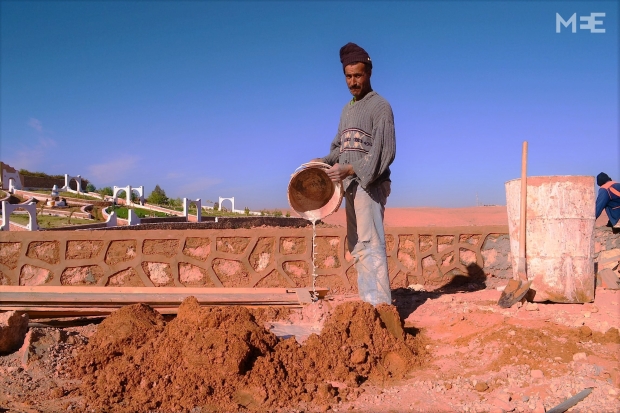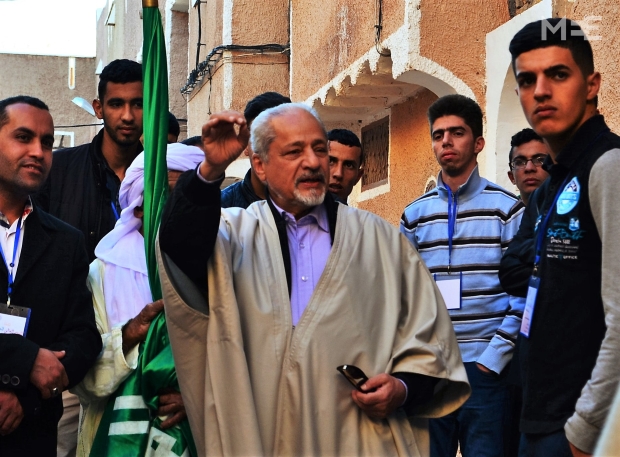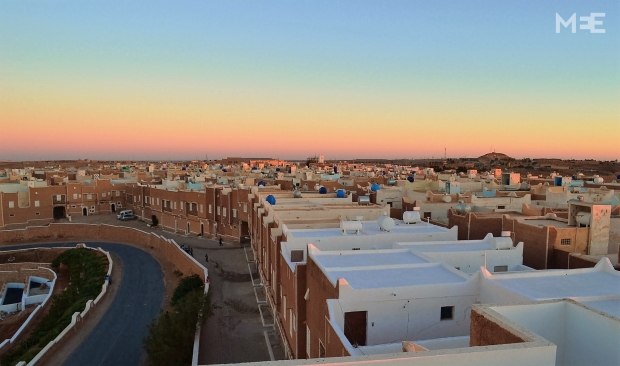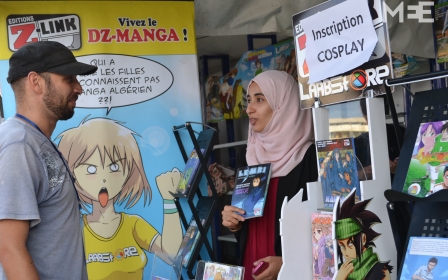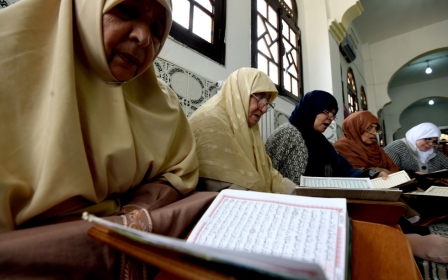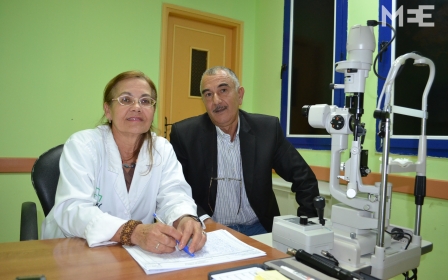Tafilalt: Algeria's first eco-friendly desert city
As we drove to the top of the hill, a terraced garden surrounded by low stone walls reared out of the desert landscape, electrified by punches of orange and yellow fruit.
An asphalt road separated this green belt from box-like buildings, with identical pastel-coloured exterior and narrow openings. The city we discovered behind an impressive gate made of palm branches was so quiet that it almost looked like an unoccupied fortress.
This oasis of calm is Tafilalt, a collection of more than 1000 hand-built houses made of local stone. Tafilalt nestles on the top of a plateau that overlooks the M’Zab Valley, in Algeria's southern Ghardaia region.
Algeria’s green champions
Ghanya was still cooking when she met with Middle East Eye. A "chorba", a traditional Algerian meatball soup, was simmering on the stove while the twentysomething woman collected food waste separately from other rubbish. Recycling has become one of Ghanya’s new routines since she moved with her husband and their little boy to Tafilalt.
In exchange for food waste, collected for feeding the animals of the newly opened local zoo, she gets fresh milk and eggs free of charge, as part of the local recycling programme. “Recycling has become a commonplace in Tafilalt,” Ghanya told MEE. “It is a fair deal: we help to recycle organic wastes and, in return, we are allowed to eat what the community produces.”
After a gruelling climb to the top of the hillside garden, Abdelaziz, wearing a black woolen cap pulled down over his forehead and a blue jacket, began digging holes to plant bougainvillea. “There is not enough room for a vegetable garden. This is why we are extending the eco-park,” the 45-year-old gardener told MEE, pointing to a nearby group of stonemasons, who were building fences on a lower level.
Standing near Abdelaziz, Mohamed supervised the construction and enjoyed a pristine view of the Beni Isguen palm grove.
“Once the expansion is completed, the inhabitants will be in charge of growing plants and vegetables as part of the city food sharing programme. The resulting harvests will be free for anyone,” the building inspector, dressed in a sarouel, the traditional Algerian trousers, told MEE. “We all aim at becoming food self-sufficient.”
Tafilalt’s eco-park is home to a variety of date palms, fruit trees and shrubs that grow without the use of chemical fertilisers or pesticides. The garden also showcases a wide range of medicinal plant species, including lavender, verbena and rosemary.
“Tafilalt will be equipped with a sophisticated pharmaceutical laboratory in the near future. We plan to produce our own traditional herbal remedies,” said Mohamed, who was among the first residents of the Saharan eco-friendly city.
Poor quality soil
But making the high desert bloom is challenging in more ways than one. “We had to entirely cover the rocky ground with four fertile topsoil layers. It took us three years to be able to start growing any plant due to the poor quality of the soil,” Abdelaziz explained. The Sahara’s green champions have also been experimenting in sustainable strategies against water shortages. They have begun to test an innovative system of wastewater treatment.
“Nothing is lost, everything is transformed in Tafilalt,” said Mohamed, showing three concrete reservoirs and pipes, set up in a corner of the eco-park. “We are using the phyto-purification technique and, so far, it has been relatively successful. We have been able to water the medicinal plants with recycled water,” he explained.
In Tafilalt, eco-friendliness is everyone’s priority. While in the rest of the country overflowing bin bags still pollute sidewalks, the narrow streets of the charming Saharan city are clean of debris. Besides garbage collector crews, families are in charge of cleaning up their neighborhood on the basis of a week-long rotation.
“It is men’s work,” Meriem, a 34-year-old woman, who draped herself in a haik, a traditional head-to-toe white outer garment allowing only one eye to be seen, told MEE. “In addition, no family takes out garbage before 7pm so that the smell of rotting trashes does not fill the air,” she added.
The environmentally forward-thinking Saharan community has also chosen the greenest education possible for the young population. Children are taught about complex environmental issues at school and regularly visit the eco-park. “This way, we become familiar with the diversity of plant species,” Ayoub, Meriem’s seven-year-old son, told MEE.
“What I like the most in Tafilalt is that nobody here has a consumerist mentality. Actually, there is only one shopping street in the city. We strive for sustainable living, focusing on what really matters,” Ali Ramdani, a 40-year-old blacksmith who covered his head with a traditional Mozabite skullcap, told MEE.
Non-profit eco-friendly project
Tafilalt has not always been a thriving oasis. Twenty years ago, a group of intellectuals, architects and scientists, coming from Beni Isguen ksar (Arabic for "castle"), banded together and created Amidoul Foundation in a bid to tackle the local housing crisis. “At that time, thousands of people were living in slums, scattered in the M’Zab Valley, because there were too few homes, usually costing too much,” Ahmed Nouh, a former pharmacist who leads the Amidoul Foundation, told MEE.
While the government launched an unprecedented housing programme, using the hydrocarbon-generated revenues to build dormitory towns across the country, Amidoul Foundation bought a rocky hill with the goal of turning it into an eco-friendly town, providing low-income housings.
“Tafilalt is a grassroots initiative with both a social and eco-conscience that intends to rehouse homeless families, while preserving the way the Mozabite community (Amazigh-speaking Berber people who originally live in the M’Zab Valley) used to relate to the natural world,” explained Nouh.
“The Holy Quran teaches us to help one another. This is the true Islam,” he added. His office is embellished by several pictures of Algeria’s desert. “That is how Tafilalt was at the beginning. There was simply nothing,” said Nouh, showing a photo of a remote desert area, taken in 1997.
Low-cost housing
According to the foundation’s president, both studio apartments and villas in Tafilalt were built at a cost “three times cheaper than the country average”.
The non-profit organisation does not expect residents to pay all at once. “We want young married couple and families in need to own the place where they live. This is why we give them the opportunity to spread out the cost of real estate over years,” Nouh explained. “We would have never dreamed of affording us a such cozy, furnished and spacious house without this payment plan,” said Meriem, sitting in her brilliant living-room.
“If a society works and takes care of its land, the people will not think about risking their lives to move somewhere else and even though some settle down abroad to work they will eventually end up going back to their land,” Nouh said.
But not anyone can reside in Algeria’s first eco-friendly city. “Life in Tafilalt is ruled by a green charter that all the inhabitants had to sign before buying a property,” Nouh said. “Our green charter includes the obligation, among others, for all the occupants to plant and grow three trees: one palm tree and two different kinds of fruit trees."
"Tafilalt was created with the idea that humans and nature can coexist,” Moussa Amara, the designer of the eco-city who just came back from an exploration in Tamanrasset, Algeria’s extreme southeastern city, told MEE.
Tafilalt was modelled on Ghardaia, a UNESCO world heritage site, known for its white-washed houses packed tightly together. “The five cities of Ghardaia were definitely a source of inspiration for us. We preserved the traditional Mozabite houses as it is a model of eco-construction and energy-saving building. We only added a new element: a patio,” Amara explained.
Neila, Ghanya’s sister-in-law, who arrived from Algiers, admired the eco-conscience of Tafilat residents, who received the Arab League’s Prize for Environment in 2014. “They are giving us a lesson of citizenship. We should not wait for green governmental reforms. The Algerian people should take initiatives that can potentially affect the environment in a positive way.”
Sitting next to her, Ghanya agreed: “Each person can make a difference.”
New MEE newsletter: Jerusalem Dispatch
Sign up to get the latest insights and analysis on Israel-Palestine, alongside Turkey Unpacked and other MEE newsletters
Middle East Eye delivers independent and unrivalled coverage and analysis of the Middle East, North Africa and beyond. To learn more about republishing this content and the associated fees, please fill out this form. More about MEE can be found here.



